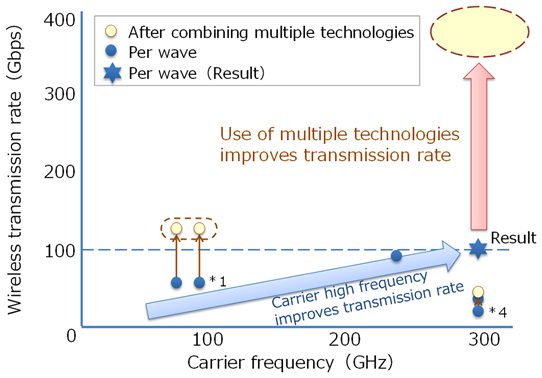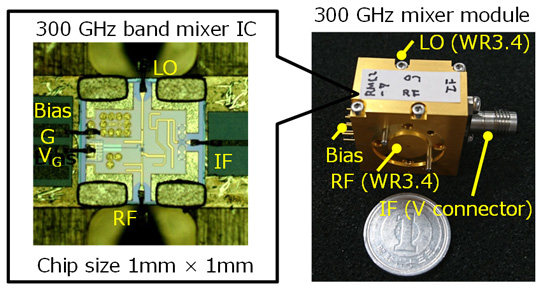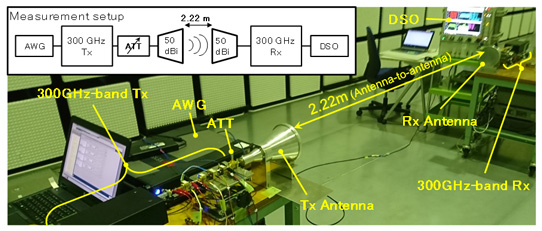- News
14 June 2018
NTT and Tokyo Institute of Technology develop IC allowing 100Gbps wireless transmission in 300GHz band
© Semiconductor Today Magazine / Juno PublishiPicture: Disco’s DAL7440 KABRA laser saw.
Tokyo-based Nippon Telegraph and Telephone Corp (NTT) and Tokyo Institute of Technology have jointly developed an ultra-high-speed IC for wireless front-ends that operates at terahertz frequencies, and in the 300GHz band they have achieved what is claimed to be the world’s fastest wireless transmission data rate, at 100Gbps – presented at the IEEE MTT-S International Microwave Symposium (IMS 2018) in Philadelphia, PA, USA (10-15 June).

Fig. 1 Development of large-capacity wireless transmission technology.
With the spread of broadband networks, high-capacity wireless transmission technology for 100Gbps has attracted global attention (Figure 1). There are three ways of further increasing the capacity of wireless transmission - expanding the transmission bandwidth, increasing the modulation multi-level number, and increasing the spatial multiplexing number. To realize future high-capacity wireless transmission technology from 400Gbps to 1 terabit per second (Tbps), it is necessary in one wave (one carrier) to expand both the transmission bandwidth and the modulation multi-level number simultaneously and to increase the number of spatial multiplexing transmissions by superposing them multiple times.
With carrier frequencies from 28GHz to 110GHz that are currently being developed, the transmission bandwidth is limited. So, researchers are studying the use of frequencies that make it easier to expand the transmission band area, from the 300GHz band to the terahertz-wave frequency band. The 300GHz band has a frequency at least 10 higher than the 28GHz band for 5G next-generation mobile communication technology. With the 300GHz band, it will be easier to secure a wide transmission bandwidth from employing as-yet unused terahertz-wave frequencies. On the other hand, with such a high frequency, there tends to be leakage of unnecessary signals between the ports inside the IC and mounting, and so far it has been impossible to achieve a sufficiently high signal-to-noise ratio (SNR). Hence, even if a 300GHz band is used, it is impossible to obtain both a wide transmission bandwidth and a high modulation multi-level value at the same time. So, wireless transmission up to now has remained at a rate of several tens of Gigabits per second (Gbps).

Fig. 2 Configuration of 300GHz wireless front end.
The researchers have now devised a proprietary high-isolation design and applied this technology to a mixer circuit (Figure 2), which is a key component responsible for frequency conversion in the 300GHz-band wireless front end. They also developed an IC using indium phosphide high-electron-mobility transistors (InP-HEMTs).
A mixer circuit has three ports: a local oscillation frequency port (LO), a radio frequency port (RF), and an intermediate frequency port (IF). When operating with the very high-frequency signals of terahertz waves, unnecessary signals leak easily between ports in the IC as the result of a small parasitic capacitance on the mixer circuit and external mounting. By adding a quarter-wave line and series capacitance, a unique design was created that dramatically improved isolation between ports. The high-isolation characteristics realized in this way can suppress the leakage of unnecessary signals, contributing not only to improved SNR but also to preventing the deterioration of frequency characteristics when the mixer IC is mounted on a module. As a result, the researchers achieved both broadband characteristics and high-SNR characteristics for a wireless front-end module.

Fig. 3 Mixer IC and module.

Fig. 4 Reception constellation by back-to-back transmission.
By using these technologies, the researchers hence realized a 300GHz-band wireless front-end module (Figure 3), and confirmed the reception of a good 16QAM signal in back-to-back transmission (Figure 4). In a 300GHz band, they also confirmed transmission at a speed of 100Gbps, the first time this speed has been attained (Figure 5).

Fig. 5 Transmission experiment.
Since 100Gbps wireless transmission was achieved using just one carrier wave, in the future this can be extended to multiple carriers by making use of the wide frequency range of the 300GHz band, as well as using spatial multiplexing technology such as MIMO and OAM. With this combination, it is expected that ultra-high-speed IC technology will enable high-capacity wireless transmission at over 400Gbps, i.e. about 400 times the data rate for existing LTE and Wi-Fi mobile communication technology and 40 times that for next-generation 5G technology. The technology is also expected to open up utilization of the unused terahertz wave frequency band in both communications and non-communication fields, such as imaging and sensing.
NTT says that, through collaboration with partners, it aims to create new services and industries using ultra high-speed ICs, as well as further developing the technology.
The work was supported in part by the R&D program on multi-tens gigabit wireless communication technology at subterahertz frequencies of Japan’s Ministry of Internal Affairs and Communications.


